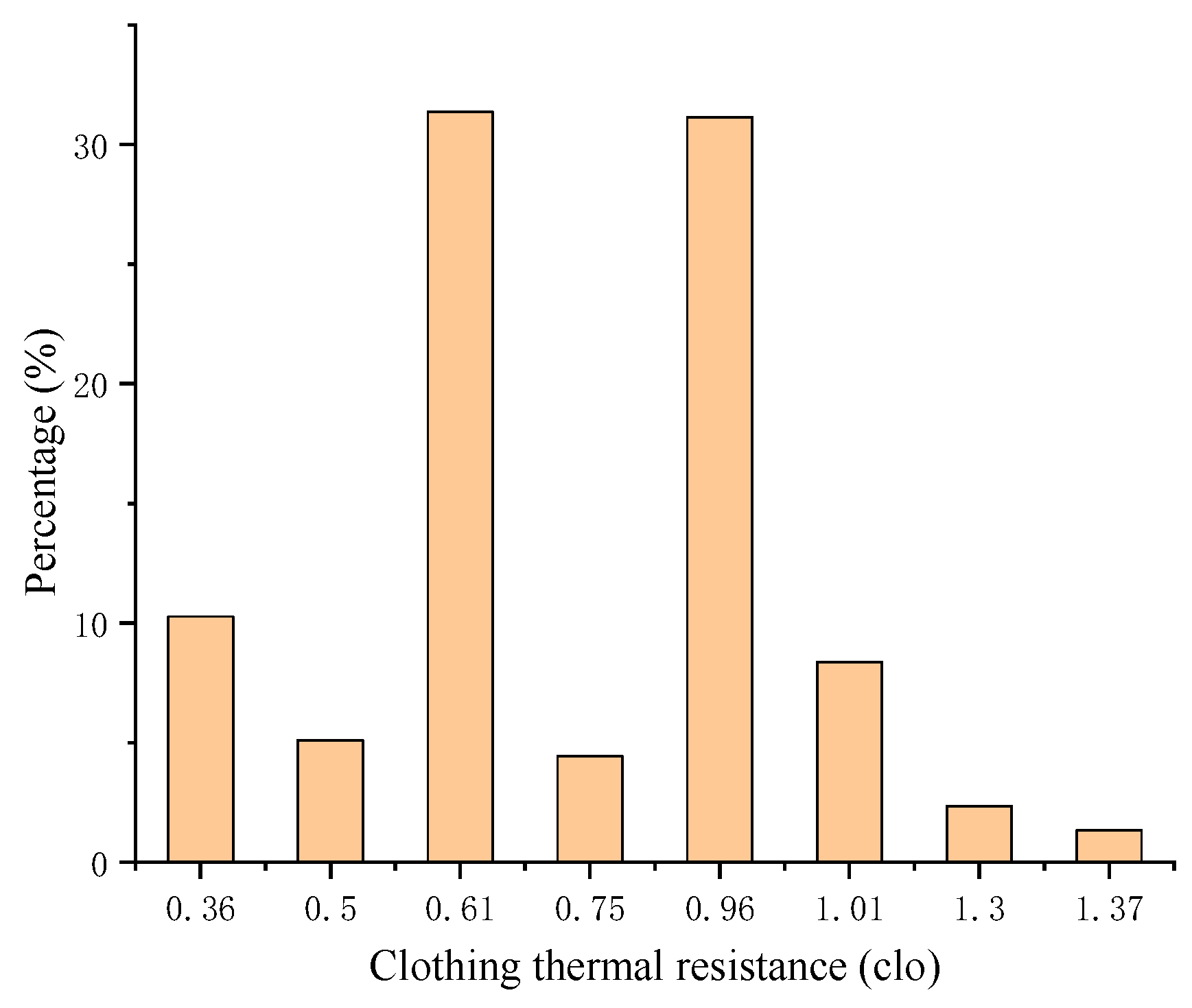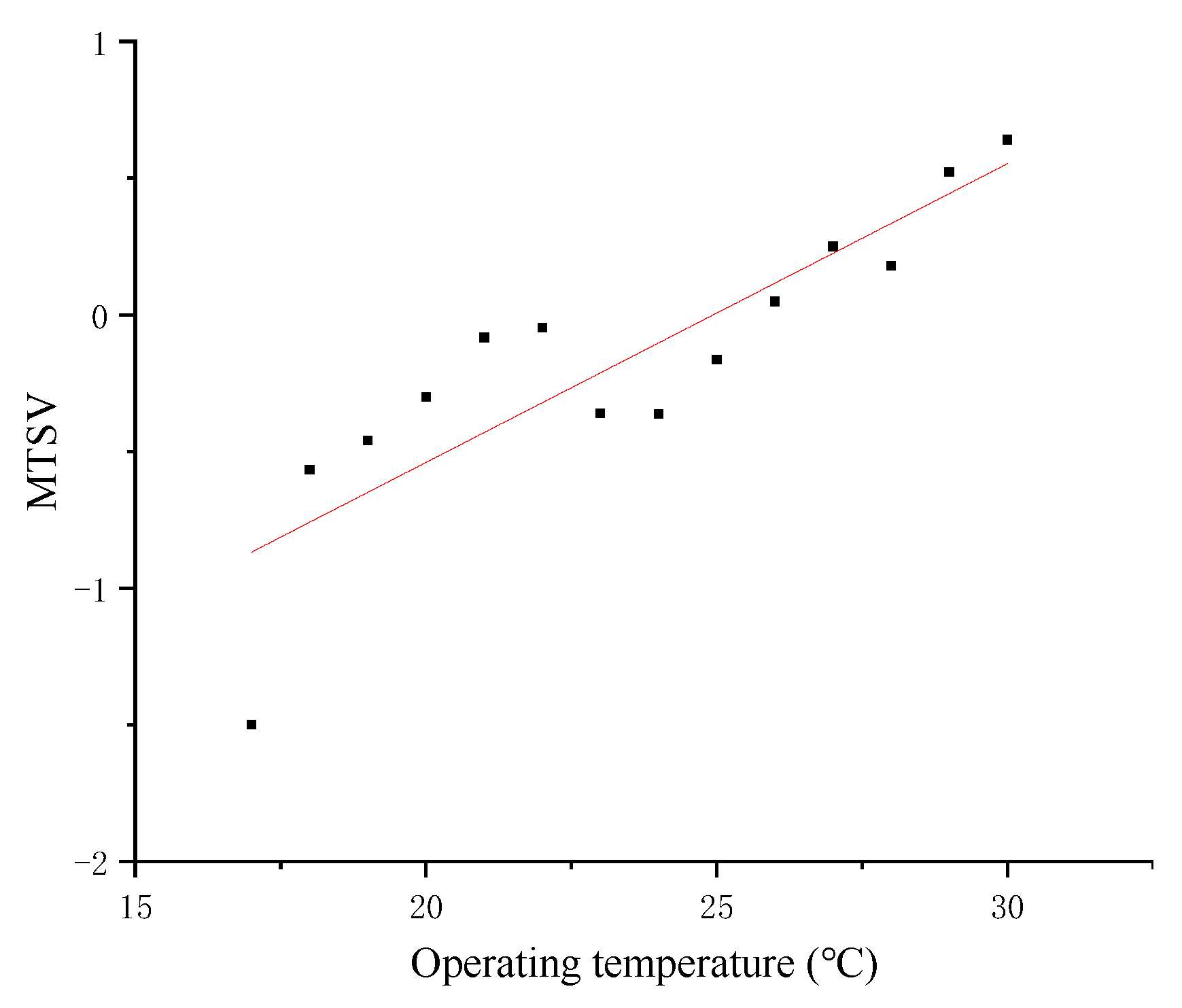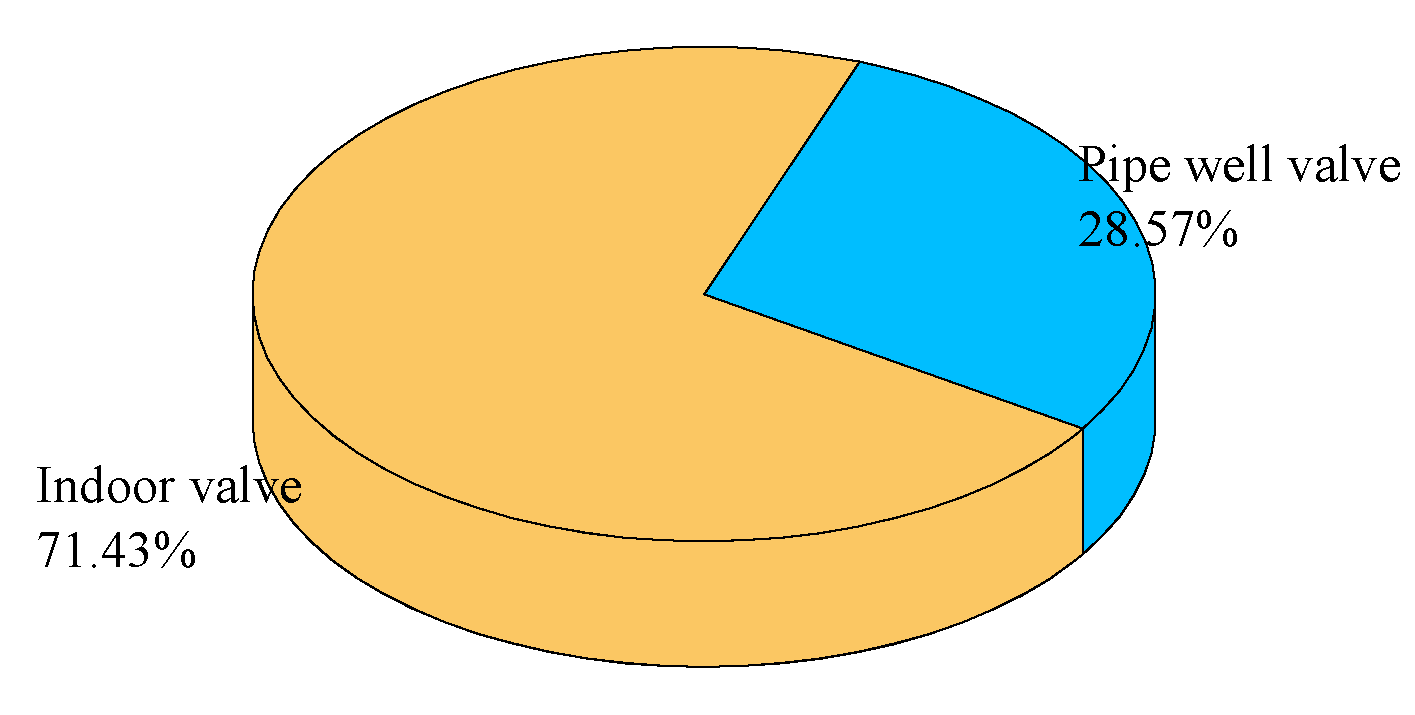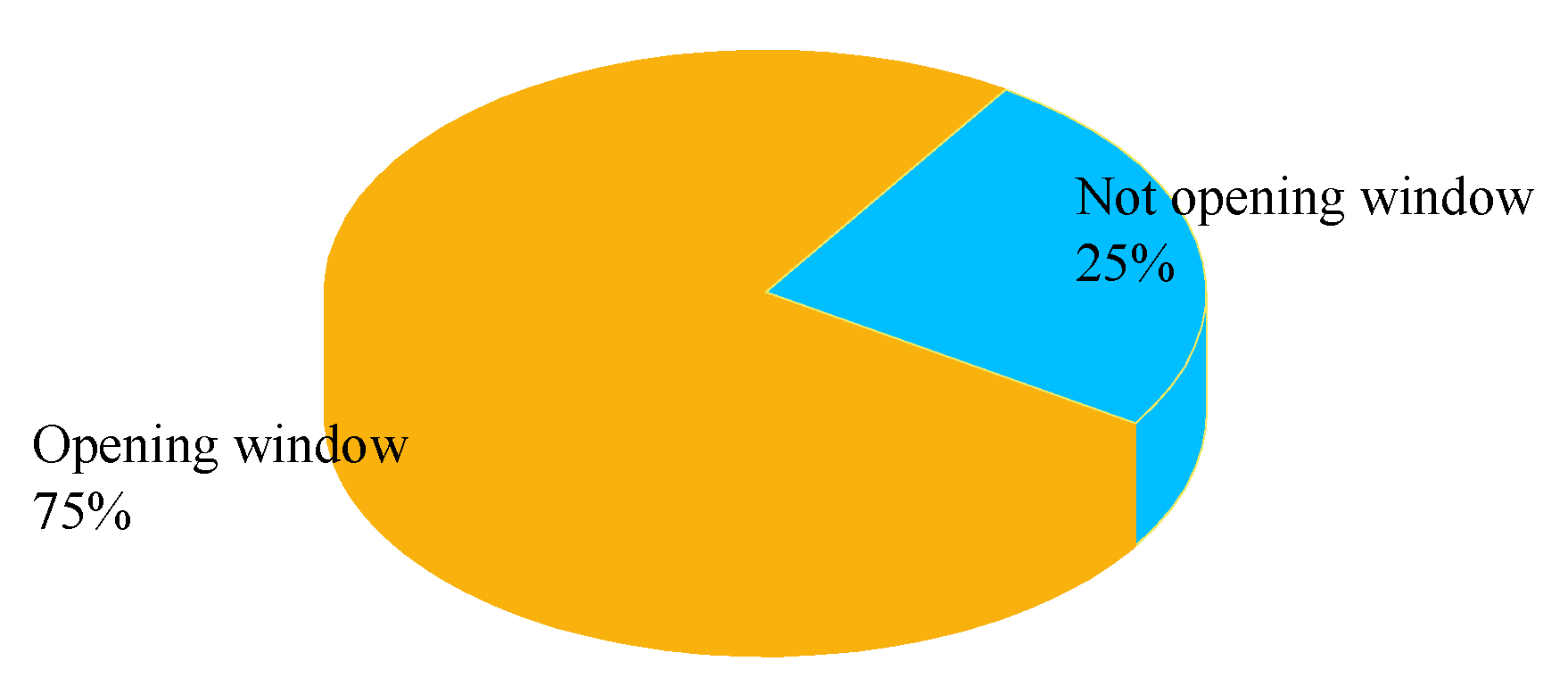Submitted:
29 August 2023
Posted:
29 August 2023
You are already at the latest version
Abstract
Keywords:
1. Introduction
2. Research Methodology
2.1. Field measurement
2.2. Survey
3. Results and analysis
3.1. Indoor thermal environment
3.1.1. Indoor thermal environment distribution
3.1.2. Satisfaction with thermal comfort
3.1.3. Acceptable temperature range
3.2. Adjusting heating end valve
3.3. Operating windows
5. Discussion
5.1. Indoor thermal environment
5.2. Heat using behavior
5.2. Heating meters propaganda
5.3. Thermostat valve
6. Conclusions
- 1)
- Indoor temperature is higher than the design temperature 20℃. Thermal neutral temperature for heat metering households is high, up to 24.8℃. The acceptable temperature range is 20.3℃~29.4℃.
- 2)
- The heat using behavior is lack of rationality. The proportion of active households is low. Indoor temperature is set high for active households. The window opening phenomenon of households is obvious during heating period, 75% households measured open their windows.
- 3)
- Active households with high indoor temperature have high probability of adjusting end valve. At the time 6:00~8:30, active households are willing to adjust the valve. High indoor temperature and outdoor temperature cause the opening window behavior of households. The probability of opening window is high at the time period of 6:00~8:30.
Acknowledgements
References
- Ürge-Vorsatz D, Cabeza LF, Serrano S, Barreneche C, Petrichenko K. Heating and cooling energy trends and drivers in buildings. Renew Sustain Energy Rev 2015, 41, 85–98. [Google Scholar] [CrossRef]
- Yang T, Pan Y, Yang Y, Lin M, Qin B, Xu P, et al. CO2 emissions in China’s building sector through 2050: A scenario analysis based on a bottom-up model. Energy 2017, 128, 208–23. [Google Scholar] [CrossRef]
- Al-Mumin A, Khattab O, Sridhar G. Occupants’ behavior and activity patterns influencing the energy consumption in the Kuwaiti residences. Energy Build 2003, 35, 549–59. [Google Scholar] [CrossRef]
- Fabi V, Andersen RV, Corgnati SP. Influence of occupant’s heating set-point preferences on indoor environmental quality and heating demand in residential buildings. HVAC R Res 2013, 19, 635–45. [Google Scholar]
- European Parliament, 2006. Directive 2006/32/EC. Off. J. Eur. Union.
- European Parliament, 2012. Directive 2012/27/EU. Off. J. Eur. Union.
- Yuan S, Xu W, Liu Y. Research of heat metering development situation and application effect evaluation model in China. Energy Policy 2016, 88, 329–42. [Google Scholar] [CrossRef]
- GB 50411-2007. The Code for Acceptance of Energy Efficient Building Construction. Beijing: China building industry press, 2007.
- Andersen RV, Toftum J, Andersen KK, Olesen BW. Survey of occupant behaviour and control of indoor environment in Danish dwellings. Energy Build 2009, 41, 11–6. [Google Scholar] [CrossRef]
- Rathouse K., Young B. RPDH15: Use of domestic heating controls, Defra’s Market Transformation.
- Programme.
- Seligman C, Darly J.M.,. Becker L.J, Behavioral approaches to residential energy conservation.
- Energy and buildings 1 (1977/78) 325–337.
- Terés-Zubiaga J, Pérez-Iribarren E, González-Pino I, Sala JM. Effects of individual metering and charging of heating and domestic hot water on energy consumption of buildings in temperate climates. Energy Convers Manag 2018, 171, 491–506. [Google Scholar] [CrossRef]
- Calise F, Cappiello F, D’Agostino D, Vicidomini M. Heat metering for residential buildings: A novel approach through dynamic simulations for the calculation of energy and economic savings. Energy 2021, 234, 121204. [Google Scholar] [CrossRef]
- Shipworth M, Firth SK, Gentry MI, Wright AJ, Shipworth DT, Lomas KJ. Central heating thermostat settings and timing: Building demographics. Build Res Inf 2010, 38, 50–69. [Google Scholar] [CrossRef]
- Wei S, Jones R, De Wilde P. Driving factors for occupant-controlled space heating in residential buildings. Energy Build 2014, 70, 36–44. [Google Scholar] [CrossRef]
- French LJ, Camilleri MJ, Isaacs NP, Pollard AR. Temperatures and heating energy in New Zealand houses from a nationally representative study-HEEP. Energy Build 2007, 39, 770–82. [Google Scholar] [CrossRef]
- Fabi V, Andersen RV, Corgnati S, Olesen BW. Occupants’ window opening behaviour: A literature review of factors influencing occupant behaviour and models. Build Environ 2012, 58, 188–98. [Google Scholar] [CrossRef]
- Journal TS, Journal TS. Energy Consumption for Space Heating : A Discrete-Continuous Approach Author ( s ): Runa Nesbakken Source : The Scandinavian Journal of Economics, Vol. 103, No. 1 ( Mar., 2001 ), pp. 165-184 Published by : Wiley on behalf of The Scandinavian Journal 2016, 103, 165–84.
- Schuler A, Weber C, Fahl U. Energy consumption for space heating of West-German households: Empirical evidence, scenario projections and policy implications. Energy Policy 2000, 28, 877–94. [Google Scholar] [CrossRef]
- Oreszczyn T, Hong SH, Ridley I, Wilkinson P. Determinants of winter indoor temperatures in low income households in England. Energy Build 2006, 38, 245–52. [Google Scholar] [CrossRef]
- Karjalainen, S. Gender differences in thermal comfort and use of thermostats in everyday thermal environments. Build Environ 2007, 42, 1594–603. [Google Scholar] [CrossRef]
- Xu B, Fu L, Di H. Field investigation on consumer behavior and hydraulic performance of a district heating system in Tianjin, China. Build Environ 2009, 44, 249–59. [Google Scholar] [CrossRef]
- Kelly S, Shipworth M, Shipworth D, Gentry M, Wright A, Pollitt M, et al. Predicting the diversity of internal temperatures from the English residential sector using panel methods. Appl Energy 2013, 102, 601–21. [Google Scholar] [CrossRef]
- Occupants’ behaviour_ determinants and__e¡ects on residential heating consumption.pdf n.d.
- Wilhite H, Nakagami H, Masuda T, Yamaga Y, Haneda H. A cross-cultural analysis of household energy use behaviour in Japan and Norway. Energy Policy 1996, 24, 795–803. [Google Scholar] [CrossRef]
- Ficco G, Celenza L, Dell’Isola M, Vigo P. Experimental comparison of residential heat accounting systems at critical conditions. Energy Build 2016, 130, 477–87. [Google Scholar] [CrossRef]
- Dell’Isola M, Ficco G, Arpino F, Cortellessa G, Canale L. A novel model for the evaluation of heat accounting systems reliability in residential buildings. Energy Build 2017, 150, 281–93. [Google Scholar] [CrossRef]
- Hansen AR, Gram-Hanssen K, Knudsen HN. How building design and technologies influence heat-related habits. Build Res Inf 2018, 46, 83–98. [Google Scholar] [CrossRef]
- Summerfield AJ, Lowe RJ, Bruhns HR, Caeiro JA, Steadman JP, Oreszczyn T. Milton Keynes Energy Park revisited: Changes in internal temperatures and energy usage. Energy Build 2007, 39, 783–91. [Google Scholar] [CrossRef]
- Sardianou, E. Estimating space heating determinants: An analysis of Greek households. Energy Build 2008, 40, 1084–93. [Google Scholar] [CrossRef]
- Bao XU, Lin FU, Hong DI. Investigation and Analysis on Consumers Dynamic Behavior in Heat - metering System 2007.
- GB50736-2012. The Design Standard for Heating, Ventilation and Air Conditioning of Civil Buildings. Beijing: China building industry press, 2012.
- Teng, S. Study on energy saving optimization of rural dwellings in cold region of Northeast China. Harbin:Harbin Institute of Technology,2018.
- ASHRAE.Thermal enviromental condition for huamn occupancy: ASHRAE Standard 55-2017.Atlanta: ASHRAE inc,2017, 4-25.
- Zhao W, Le L. Field study on thermal comfort of residents in Harbin city in winter 2002. Journal of Harbin Institute of Technology, 2002; 500–504.
- Jian Yang,Tian Ye, Kun Li. Research on occupant window opening behavior based on Logistic regression and Average Bayesian network, 2020, 50, 135–140+121.













| Time | Content | Regulations and Technical standards |
|---|---|---|
| 1995 | Planning the installation of heat meters | The 9th Five-year Plan and 2010 Plan for Building Energy Conservation of the Ministry of Construction |
| 1999 | Room temperature regulation is suggested when designed | Code for Residential Building Design GB50096-1999 |
| 1999 | Implement temperature regulation and heat metering device for new building | Provisions on the administration of energy conservation in civil buildings |
| 2003 | Gradually implement charging by heat metering | Guidance on the Pilot Work of Urban Heating System Reform |
| 2007 | Indoor temperature control devices and thermal control metering devices must be installed mandatorily | Code for Acceptance of Energy Efficient Building Construction |
| 2008 | The energy saving retrofit of heating system should be carried out synchronously with the retrofit of heat metering | Technical Guidelines for Heating Metering and Energy Saving Renovation of Existing Residential Buildings in Northern Heating Area |
| 2008 | Formulating measures for the administration of heating metering in civil buildings | Measures for The Administration of Heating Metering in Civil Buildings |
| 2008 | The heat metering design of new buildings and the retrofit of existing buildings are stipulated | Technical Guidelines for Heating Metering |
| No | Variable | Descriptive | scales | |
|---|---|---|---|---|
| 1 | Behavior of adjusting heating end valve | The indoor temperature setpoint in this morning | ||
| 2 | The time for adjusting heating end valve | |||
| 3 | Indoor temperature after adjusting heating end valve | |||
| 4 | Behavior of window operating | Time of opening window for master bedroom | ||
| 5 | Time of opening window for living room | |||
| 6 | Time of opening window for guest bedroom | |||
| 7 | Thermal comfort | |||
| 8 | Thermal sensation | Very cold | -3 | |
| 9 | Cold | -2 | ||
| 10 | Slightly cold | -1 | ||
| 11 | Moderate | 0 | ||
| 12 | Slightly hot | 1 | ||
| 13 | Hot | 2 | ||
| 14 | Very hot | 3 | ||
| 15 | Thermal comfort | Comfortable | 0 | |
| 16 | Slightly uncomfortable | 1 | ||
| 17 | Uncomfortable | 2 | ||
| Very uncomfortable | 3 | |||
| 18 | Intolerable | 4 | ||
| 19 | Thermal environment acceptance | Very unreceptive | -3 | |
| 20 | Unreceptive | -2 | ||
| Slightly unreceptive | -1 | |||
| 21 | Moderate | 0 | ||
| 22 | Just acceptive | 1 | ||
| 23 | acceptive | 2 | ||
| 24 | Very acceptive | 3 |
| Clothing | Thermal resistance(clo) | Clothing | Thermal resistance(clo) |
|---|---|---|---|
| Pants, short-sleeved shirts, socks, shoes | 0.57 | Shorts, short-sleeved shirts, shoes socks | 0.36 |
| Pants, long-sleeved shirts, shoes and socks | 0.61 | Long-sleeved overalls, T-shirts, shoes and socks | 0.72 |
| Jackets, pants, long-sleeved shirts, socks | 0.96 | Long-sleeved overalls, long-sleeved shirts, shoes and socks | 0.89 |
| Jackets, vests, trousers, long-sleeved shirts, socks | 1.14 | Insulated work clothes, long Johns, shoes and socks | 1.37 |
| Trousers, long-sleeved shirts, long-sleeved sweaters, shoes and socks | 1.30 | Long sleeved sweatshirts, sweatpants, shoes and socks | 0.74 |
| Knee-length skirt, short-sleeved shirt, sandals | 0.54 | Full pyjamas, slippers, no socks | 0.96 |
| Long skirts, long sleeved shirts, jackets, | 1.1 |
| Factors | B | Beta | t | Sig | |
|---|---|---|---|---|---|
| Constant | -4.46 | -7.34 | 0.00 | ||
| Indoor temperature before adjustment | 0.19 | 0.61 | 7.06 | 0.00 | |
| Time period | 0.13 | 0.26 | 2.97 | 0.00 | |
| Outdoor temperature | - | 0.05 | 0.43 | 0.67 | |
| Outdoor wind speed | - | 0.11 | 1.08 | 0.28 | |
| Indoor relative humidity | - | -0.10 | -1.24 | 0.22 |
| Variable | B | Beta | t | Sig |
|---|---|---|---|---|
| Constant | 0.03 | 3.41 | 0.00 | |
| Outdoor temperature | 0.02 | 0.15 | 14.08 | 0.00 |
| Time period | 0.19 | 0.39 | 35.70 | 0.00 |
| Indoor temperature before opening window | 0.03 | 3.41 | 0.00 | |
| Indoor relative humidity | - | -0.01 | -0.76 | 0.34 |
Disclaimer/Publisher’s Note: The statements, opinions and data contained in all publications are solely those of the individual author(s) and contributor(s) and not of MDPI and/or the editor(s). MDPI and/or the editor(s) disclaim responsibility for any injury to people or property resulting from any ideas, methods, instructions or products referred to in the content. |
© 2023 by the authors. Licensee MDPI, Basel, Switzerland. This article is an open access article distributed under the terms and conditions of the Creative Commons Attribution (CC BY) license (https://creativecommons.org/licenses/by/4.0/).




